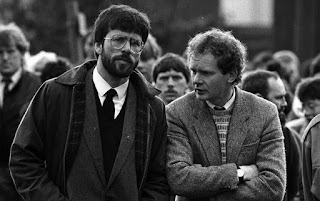In times of such great uncertainty, it helps to be able to look into the past and see how those who came before us grappled with the hand that fortune dealt them. In the rich, yet tragic history of this great Celtic land, lie great stories, which, when recounted, inspire anew. In a new series, The Fair Observations looks back and tries to give a fair and balanced account of what happened before us.
Sinn Féin
 |
| Arthur Griffith |
According to a 1947 High Court ruling, the contemporaneous Sinn Féin was not the same party as that established by Arthur Griffith. Yet, the party celebrated its centenary in 2005. This has lead historians to believe that Sinn Féin became etherial and ghost-like between 1926 and 1970. In these years, it drifted across the island, partially materialising from time to time. Finally, it reified in Northern Ireland, when the Troubles began. The newly manifested party represented the IRA by refusing to take the seats they won in parliament, being banned from appearing in British and Irish media, and by denying they represented the IRA (not that they had the communicative means to do so). Members of Sinn Féin (or 'Sinn Féin IRA' in Ulster Scots) would often talk to a wall, in front of a video camera, in order to maintain the semblance of being a political party.
After successfully negotiating the Northern Ireland peace process, Sinn Féin decided to try and regain their ill-fated dominance across the whole of Ireland. In the last general election, the party more than doubled their number of seats in Dáil Éireann. They offer political change in the Republic under the leadership of Gerry Adams (who, in the spirt of dual monarchy, has led Sinn Féin for 30 years with Martin McGuinness ).1 They have found support among the working classes, those of us who like to see 'gurriers' getting a good beating, and 1916 Rising cosplay enthusiasts.
Sinn Féin means 'ourselves', but it is often translated with greater poetic eloquence, rendering this mere reflexive pronoun in more exciting forms: 'we alone', 'we stand alone', 'I'm so lonely', and 'a loan' (from Britain). The party's motto is Tiocfaidh ár lá, which translates as 'our day will come'. This has now been made redundant, as their day came quite recently, when Glasgow Celtic beat the world's best football team in the Champions League, during a season where Glasgow Rangers play in the Scottish Third Division. The following day, British prime minister David Cameron and his cabinet began plotting to re-conquer Ireland, inaugurating the dreaded 1,000 years of brutal British rule.
 |
| I'm not saying these guys were fascists, but... |
1 I'd like to thank Feichin for this idea.

No comments:
Post a Comment